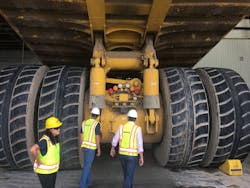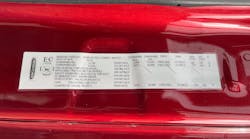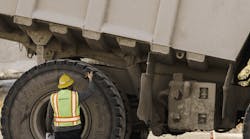REMA Tip Top OTR (Off The Road) Repair System comprises three components: repair products; a wide range of vulcanizing machines; and a training program run by specialized professionals—directly on-site, if desired. This repair system permits high-value OTR tires to be permanently repaired, even after mechanical damage, the company says.
Here are the steps. First, inspect the tire to find the exact point and size of the injury/cut.
Then skive the area, which is essentially gouging out the area around the problem. Buff the skived area, making a larger, smoother hole.
Taper the skived area to 45 degrees and wire brush the buffed skive.
Cut around the injury, creating a channel, then buff the injury channel. Select the proper repair unit for the tire, by matching the tire's ply and the maximum injury size.
Make a center line for the repair with chalk (marking a cross or "X" with the injury at the center). Position the repair unit over the injury, and outline the repair unit with chalk.
Make two more outlines, first one inch smaller than the repair unit, then the other one inch larger. Skive through the inner liner and two plies (the inner line).
Taper to 60 degrees from the inner line to the middle line, then buff to the outer line.
Skive with a wire brush. Next, wire brush the buffed area and remove buffing debris with a vacuum. Cement the first coat with a brushed-on cement.
Recheck the injury size with a tape measure, then cement a second coat.
Vent the skived area using a string-like "vent cord." Remove the poly coating from the tire side of the repair unit (patch) and center it over the injury. Cement the repair unit over the injury. Use a rubber mallet to hammer it in place.
Now remove the poly from the outer (facing) side of the repair unit. Stitch the repair unit. Fill the tapered area with cushion gum and stitch thoroughly. Trim the excess rubber.
For all four edges of the repair area, do the following: cement the outside edge, strip it, stitch with a porcupine stitcher, and stitch the edges of the cushion gum.
Trim any excess cushion gum along the way. When all four sides are done, fill the skive with cushion gum. Stitch it thoroughly.
Line the skive with cushion gum and stitch thoroughly, as well. Trim the excess rubber. Repeat for all sides. Finally, trim the excess vent cord that is sticking out.
REMA Tip Top/North America, based in Northvale, N.J., is the largest subsidiary of REMA Tip Top AG, headquartered in Poing, Germany.
With facilities in over 170 countries throughout the world, the company specializes in tire-repair products, surface protection (corrosion protection and wear protection), and material processing (conveying solutions and conveyor belts).





